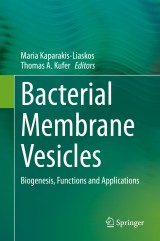Details

Bacterial Membrane Vesicles
Biogenesis, Functions and Applications|
160,49 € |
|
| Verlag: | Springer |
| Format: | |
| Veröffentl.: | 31.03.2020 |
| ISBN/EAN: | 9783030363314 |
| Sprache: | englisch |
Dieses eBook enthält ein Wasserzeichen.
Beschreibungen
<p></p><p>This book focuses on the multitude of functions bacterial membrane vesicles perform in bacterial ecology and pathogenesis as well as in emerging medical and biotechnological applications. Both Gram-negative and Gram-positive bacteria produce membrane-bound nanostructures, known as membrane vesicles, which have a range of functions that include serving as delivery vehicles, providing a means of communication over both spatial and temporal scales, and contributing to bacterial survival and evolution. Topics covered in this book range from the biogenesis and composition of bacterial membrane vesicles to their abundance and biological roles in microbial ecosystems, such as marine environments. In the individual chapters, the involvement of bacterial membrane vesicles in host-pathogen interactions, promoting virulence and in facilitating the establishment of infection is explained. In addition, current knowledge regarding membrane vesicles produced by commensal bacteria and their role in the maturation of the host immune system, as well as the therapeutic potential of bacterial membrane vesicles as delivery systems and innovative nanotechnology-based therapeutics are discussed.</p><p> </p><p>This work appeals to a wide readership of students and researchers interested in microbial ecology, mechanism underlying pathogenesis and new avenues in applied microbiology and nanotechnology.</p><p></p>
<p></p><p>Table of content</p><p>Chapter 1: Introduction, History and Discovery of Bacterial Membrane Vesicles </p><p>Lauren Zavan, Natalie J. Bitto1 and Maria Kaparakis-Liaskos</p><p>Chapter 2: Biogenesis of Gram-negative OMVs </p><p>Franz G. Zingl, Deborah R. Leitner and Stefan Schild</p><p>Chapter 3: Biogenesis and Function of Extracellular Vesicles in Gram-positive Bacteria, Mycobacteria and Fungi</p><p>Ainhoa Palacios, Carolina Coelho, Maria Maryam, Jose L. Luque-García, Arturo Casadevall and Rafael Prados-Rosales </p><p>Chapter 4: Extracellular vesicles in the environment</p><p>Steven J. Biller </p><p>Chapter 5: Functions of MVs in inter-bacterial communication</p>Masanori Toyofuku, Yosuke Tashiro, Nobuhiko Nomura, and Leo Eberl<p></p><p>Chapter 6: Membrane Vesicles From Plant Pathogenic Bacteria and Their roles During Plant-Pathogen Interactions</p><p>OfirBahar</p><p>Chapter 7: Delivery of virulence factors by bacterial membrane vesicles to mammalian host cells</p><p>Aftab Nadeem, Jan Oscarsson and Sun Nyunt Wai </p><p>Chapter 8: Immunodetection and pathogenesis mediated by bacterial membrane vesicles</p><p>Ella L. Johnston, Thomas A. Kufer and Maria Kaparakis-Liaskos</p><p>Chapter 9: Membrane Vesicles from the Gut Microbiota and their Interactions with the Host</p><p>JosefaBadia and Laura Baldomà</p><p>Chapter 10: Bacterial Membrane Vesicles and Their Applications as Vaccines and in Biotechnology</p><p>Julie C. Caruana and Scott A. Walper</p><p></p>
<p></p><p><b><i>Associate Professor Maria Kaparakis-Liaskos</i></b></p><p>Associate Professor Maria Kaparakis-Liaskos is Head of the Host-pathogen Interactions and Bacterial Membrane Vesicles Laboratory at La Trobe University, Australia. She is also the Deputy Director of the La Trobe Research Centre for Extracellular Vesicles. Her recent research activities focus on understanding the cellular and molecular mechanisms of host-pathogen interactions with particular focus on bacterial membrane vesicles.</p><p>Associate Professor Kaparakis-Liaskos obtained her PhD from the Department of Microbiology and Immunology at the University of Melbourne in Australia in 2005. She then undertook post-doctoral studies at Monash University, working on innate immune responses to <i>Helicobacter pylori</i> and bacterial outer membrane vesicles. She then headed a research group at the Hudson Institute of Medical Research, Australia during which time she identified the mechanisms whereby OMVs were detected by NOD1 and were degraded by autophagy. In 2016, she joined La Trobe University in Melbourne, Australia, where her research is supported by the Australian Research Council (ARC), the National Health and Medical Research Council (NHMRC) and the Victorian Endowment for Science Knowledge and Innovation (veski).</p><p> <b><i>Professor Thomas A. Kufer</i></b></p><p>Professor Thomas Kufer is head of the Department of Immunology at the University of Hohenheim, Stuttgart, Germany. His primary research interests are focused on understanding the functions of NLR proteins in host-pathogen interactions, immunity and inflammation.</p>Professor Kufer obtained his PhD (Dr. rer. nat.) in Cell Biology from the Ludwig-Maximilians University of Munich in 2004. He then undertook post-doctoral studies in the laboratories of Dana Philpott and Philippe Sansonetti in the Pasteur Institute in Paris working on the intracellular pattern recognition receptors NOD1 and NOD2 in the context of <i>Shigella flexneri</i> infection. Subsequently he headed a junior research group funded by the German Research Foundation (DFG) at the Institute of Medical Microbiology, Immunology and Hygiene at University of Cologne in Germany working on innate immune responses mediated by NLR proteins. In 2014 he was recruited at the University of Hohenheim as professor for immunology.<p></p><p> </p><p> </p><p></p>
<p></p><p>This book focuses on the multitude of functions bacterial membrane vesicles perform in bacterial ecology and pathogenesis as well as in emerging medical and biotechnological applications. Both Gram-negative and Gram-positive bacteria produce membrane-bound nanostructures, known as membrane vesicles, which have a range of functions that include serving as delivery vehicles, providing a means of communication over both spatial and temporal scales, and contributing to bacterial survival and evolution. Topics covered in this book range from the biogenesis and composition of bacterial membrane vesicles to their abundance and biological roles in microbial ecosystems, such as marine environments. In the individual chapters, the involvement of bacterial membrane vesicles in host-pathogen interactions, promoting virulence and in facilitating the establishment of infection is explained. In addition, current knowledge regarding membrane vesicles produced by commensal bacteria and their role in the maturation of the host immune system, as well as the therapeutic potential of bacterial membrane vesicles as delivery systems and innovative nanotechnology-based therapeutics are discussed.</p><p> </p><p>This work appeals to a wide readership of students and researchers interested in microbial ecology, mechanism underlying pathogenesis and new avenues in applied microbiology and nanotechnology.</p><p></p>
<p>Covers the biogenesis and composition of bacterial membrane vesicles</p><p>Highlights the various functions extracellular vesicles have in bacterial ecology and pathogenesis</p><p>Outlines new avenues in applied microbiology and the development of new vaccines and therapies</p><p>Discusses the roles of membrane delivery vehicles in bacterial communities and host interactions</p>
Diese Produkte könnten Sie auch interessieren:

Tropical and Parasitic Infections in the Intensive Care Unit

von: Charles Feldman, George A. Sarosi

149,79 €















